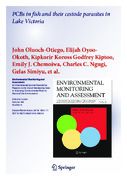| dc.description.abstract | Polychlorinatedbiphenyls(PCBs)areclassified as persistent organic pollutants (POPs) regulated by the Stockholm Convention (2001). Although their production and use was stopped almost three decades ago, PCBs are environmental persistent, toxic, and bioaccumulate in biota. We assessed the levels of 7 PCB congeners (IUPAC nos. 28, 52, 101, 118, 138, 153, and 180) in sediment and fish (Oreochromis niloticus, Lates niloticus, and Rastrineobola argentea) and evaluated the potential of cestode fish endoparasite (Monobothrioides sp., Proteocephalaus sp., and Ligula intestinalis) as biomonitorsofPCBsinLakeVictoria,Kenya.Themedian concentrationof Σ7PCBsinsedimentsandfishwere2.2– 96.3 μg/kg dw and 300–3,000 μg/kg lw, respectively. At all the sampling sites, CB138, CB153, and CB180 were the dominant PCB congeners in sediment and fish samples. Compared to the muscle of the piscine host, Proteocephalaus sp. (infecting L. niloticus) biomagnified PCBs ×6–14 while Monobothrioides sp. (infecting O. niloticus) biomagnified PCBs ×4–8. Meanwhile, L. intestinalis (infecting R. argentea) biomagnified PCBs ×8–16 compared to the muscle of unparasitized fish. We demonstrate the occurrence of moderate to high levels of PCB in sediments and fish in Lake Victoria. We also provide evidence that fish parasites bioaccumulate higher levels of PCBs than their piscine hosts and therefore provide apromising biomonitor of PCBs. Weurgefurther a long-term study to validate the use of the above cestode fish parasites as biomonitoring tools for PCBs. | en_US |
